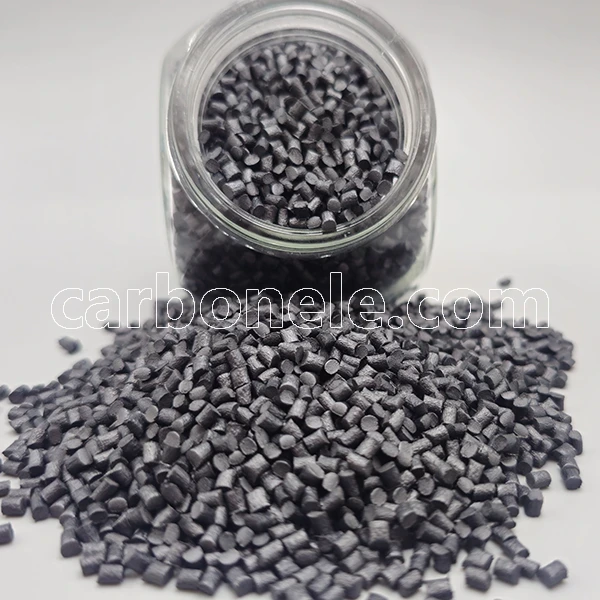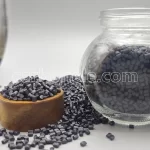
High Temperature Resistant PEEK CF40 Composites
PEEK CF40%, as a carbon fiber-reinforced thermoplastic, is widely recognized for its exceptional mechanical properties, outstanding thermal stability, and superior chemical resistance. Its wide-ranging applications in the aerospace, automotive, and medical fields are a clear testament to its high performance and reliability. The scrupulous control exercised over the manufacturing process ensures the material’s consistent quality and effectiveness, firmly establishing PEEK CF40 as a premier choice for demanding high-performance engineering applications.
- Model No.: PEEK-CF-BCA4
An Application Case about PEEK 40% CF
Let’s consider a scenario in the aerospace industry where PEEK CF40 is utilized to great effect. Imagine a cutting-edge commercial aircraft engine component – a turbine blade. Traditional materials often struggled to meet the rigorous demands of high temperatures, intense mechanical stresses, and lightweight requirements simultaneously.
However, with PEEK CF40, a revolutionary change occurred. The turbine blade was crafted using this advanced material. The carbon fiber reinforcement within PEEK – CF40 significantly enhanced the blade’s tensile strength and rigidity, allowing it to withstand the extreme rotational forces and pressure differentials within the engine.
The excellent thermal stability of PEEK-CF40 enabled the blade to maintain its integrity and performance even at temperatures exceeding 200°C. This reduced the need for frequent maintenance and replacements, contributing to increased operational efficiency and reduced downtime for the aircraft.
The lightweight nature of PEEK+CF40 also played a crucial role. It helped in reducing the overall weight of the engine, which in turn led to decreased fuel consumption and lower emissions. The superior chemical resistance of the material ensured that it remained unaffected by the harsh chemicals present in the engine lubricants and combustion byproducts.
The use of PEEK + CF40% in this turbine blade application not only improved the performance and reliability of the aircraft engine but also had a positive impact on the airline’s operational costs and environmental footprint.
What’s PEEK CF40?
PEEK CF40, a carbon fiber-reinforced thermoplastic, stands as a highly sophisticated and advanced engineering plastic boasting exceptional properties and an extensive array of applications. It is meticulously crafted by fortifying the base of Polyether Ether Ketone (PEEK) with carbon fibers, thereby yielding a material of extraordinary performance. Here is an elaborate and detailed introduction to PEEK 40% CF, encompassing its diverse applications, remarkable performance characteristics, and intricate manufacturing process.
What Other Applications PEEK – 40%CF Possesses?
The carbon fiber reinforcement of PEEK CF40 renders it eminently suitable for a wide gamut of industries. It is particularly held in high regard in the aerospace sector, where it is employed to fabricate lightweight yet exceptionally high-strength components. This not only enhances the performance of aircraft but also leads to a reduction in fuel consumption, contributing to increased efficiency and sustainability. In the automotive domain, PEEK Carbon Fiber 40% finds application in engine and transmission parts, significantly enhancing their wear resistance and thermal stability. This ensures that these components can withstand the intense heat and mechanical stresses associated with the operation of modern automotive systems. In the medical field, its utilization in surgical tools and implants is driven by its outstanding biocompatibility and chemical resistance. These attributes are of paramount importance as they ensure precision and durability, minimizing the risk of adverse reactions and maintaining the integrity of the medical devices over time.
What Performance Characteristics PEEK+40%CF Has?
PEEK CF40 showcases a plethora of remarkable properties. Firstly, its mechanical performance is truly exceptional. The incorporation of carbon fibers leads to a significant enhancement in tensile strength and rigidity when compared to pure PEEK. This makes it an ideal choice for applications that demand high load-bearing capacity, such as in structural components subjected to heavy loads or dynamic forces. Secondly, it demonstrates excellent thermal stability, maintaining its mechanical and physical properties even in environments with temperatures up to 250°C. This high-temperature stability is crucial for ensuring consistent performance in extreme operating conditions, such as in aerospace engines or industrial processes involving high heat. Thirdly, PEEK CF 40% offers superior chemical resistance, capably withstanding exposure to a wide variety of chemicals, including strong acids, bases, and solvents. This characteristic is essential in applications within the chemical processing and manufacturing industries, where the material is exposed to aggressive chemical environments without undergoing degradation or loss of performance. Additionally, its low friction coefficient and outstanding wear resistance make it highly suitable for applications where minimizing friction and wear is of critical importance, such as in mechanical systems where smooth operation and long component life are essential.
How to Obtain PEEK – CF 40%? (Manufacturing Process)
The production of PEEK CF 40 encompasses several crucial and meticulous steps. Firstly, the carbon fibers undergo a specialized treatment process to optimize their compatibility and dispersion within the PEEK matrix. Subsequently, they are precisely mixed with PEEK resin to achieve a homogeneous distribution. The resulting mixed material is then processed using either extrusion or injection molding techniques. Extrusion involves heating the material to a molten state and then exerting controlled pressure to force it through a precisely designed mold, resulting in the formation of shapes such as long bars or sheets. On the other hand, injection molding entails injecting the molten PEEK CF 40% material into intricately shaped molds. The material is then rapidly cooled to solidify and create complex-shaped components. Throughout the manufacturing process, precise control of temperature, pressure, and cooling rates is imperative to ensure the material’s quality and performance. Any deviation from the optimal parameters could potentially lead to premature degradation of the material or inconsistent properties. This meticulous control guarantees that the final product meets the stringent requirements of high-performance engineering applications.
Should you have any interest in carbon fiber reinforced PEEK composites, please feel free to contact me. For more videos related to CFRTPs, please click here.
Advanced Production Technique
Carbon (Xiamen) New Material is equipped with state-of-the-art carbon fiber composite production processes and contemporary facilities. It has highly automated layup devices for precise fiber handling, ensuring the uniformity of mechanical properties. Advanced curing methods such as vacuum-assisted or autoclave curing boost both efficiency and product quality. The company also makes regular investments in research and development to introduce pioneering production technologies, enhancing its ability to meet diverse customer demands and stay at the leading edge of the competitive market. For example, their recent creation of a new layup approach has considerably reduced production time without sacrificing quality.

Professional R & D Team
Carbon (Xiamen) New Material possesses a group of experienced material scientists, engineers, and technical specialists. They promote innovation and product enhancement. Material scientists improve interfaces, engineers refine designs, and specialists utilize technology for monitoring and efficiency. The team actively takes part in industry conferences and workshops, cultivating a culture of learning and knowledge sharing, which results in continuous progress in product development and process optimization. Their recent achievement in a new material formulation is a proof of the team's proficiency.

Frequently Asked Questions
Carbon (Xiamen) New Material Co., Ltd. aims to provide buyers with "one-stop" worry-free high-quality services. Here you can find all information about carbon fiber engineering plastics. If you still have questions, please send us an email for consultation!
-
How can I contact the manufacturer of a product that interests me?
When you find a product you are interested in, you can contact the manufacturer directly by sending an email and we will get back to you as soon as possible.
-
How do I find the products that interest me?
All you need to do is enter the keyword, product name in the search window and press the Enter key on your keyboard. Your search results page will then be displayed. You can also search within the product category pages on the home page. Each category is divided into subcategories, allowing you to refine your search and find products that interest you.
-
Where will I find a buying guide?
Please contact our after-sales service directly and we will provide you with a comprehensive operating guide.
-
What are CF Reinforced Thermoplastic Composites?
CF Reinforced Thermoplastic Composites are materials where carbon fibers are incorporated into a thermoplastic matrix. They combine the strength and stiffness of carbon fibers with the processability and recyclability of thermoplastics. For instance, they are used in automotive parts like bumper beams.
-
What are the benefits of CF Reinforced Thermoplastic Composites over traditional composites?
The key benefits include faster production cycles, easier recyclability, and better impact resistance. They also offer design flexibility. An example is in the manufacturing of consumer electronics casings where complex shapes can be achieved more easily.
-
How are CF Reinforced Thermoplastic Composites processed?
Common processing methods include injection molding, extrusion, and compression molding. Injection molding is widely used for mass production. For example, in the production of small components for the medical industry.
-
What industries use CF Reinforced Thermoplastic Composites?
They are utilized in aerospace, automotive, medical, and sports equipment industries. In aerospace, they can be found in interior components. In the medical field, they might be used in prosthetics.
-
How does the carbon fiber content affect the properties of the composites?
Higher carbon fiber content generally leads to increased strength and stiffness but may reduce ductility. A moderate content is often balanced for specific applications. For example, a higher content might be preferred in structural parts of a race car.
-
What are the challenges in using CF Reinforced Thermoplastic Composites?
Challenges include higher material costs, complex processing equipment requirements, and ensuring uniform fiber dispersion. Issues with adhesion between the fibers and the matrix can also arise. An example is in achieving consistent quality in large-scale production.























